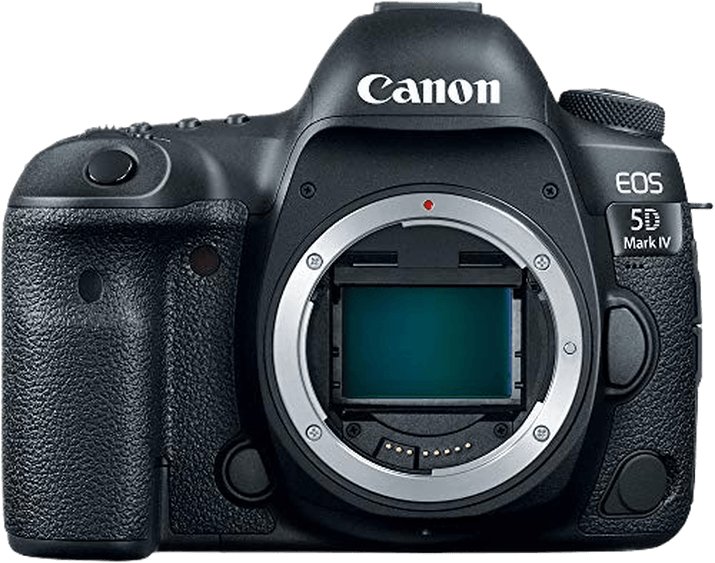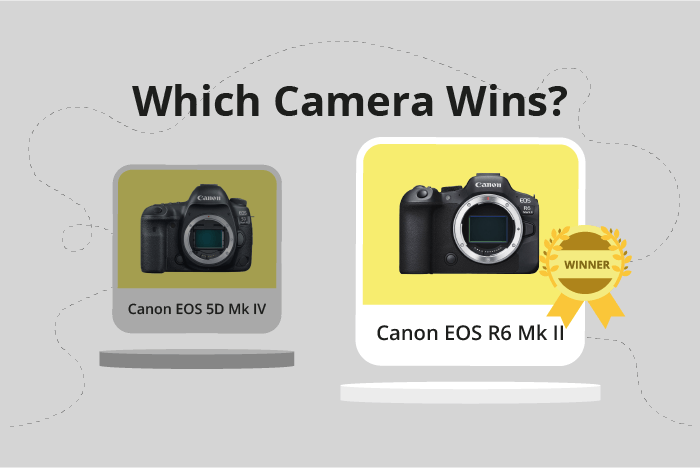Canon EOS 5D Mark IV vs EOS R6 Mark II Comparison
Canon EOS 5D Mark IV

Canon EOS R6 Mark II

The Canon EOS R6 Mark II takes the lead with a score of 78/100, compared to the Canon EOS 5D Mark IV‘s 75/100. Both cameras share similarities, such as being part of the Canon family and having impressive specifications. However, the R6 Mark II stands out as a mirrorless camera, released in 2022 with a more affordable launch price of $2499. Its compact size of 138.4 x 98.4 x 88.4mm and lighter weight of 588g also make it a more convenient option for photographers.
On the other hand, the 5D Mark IV, a DSLR released in 2016, boasts a solid performance despite its higher launch price of $3500 and larger size (151 x 116 x 76mm) and weight (890g). Its durability and long-standing reputation in the photography world still make it a strong contender.
Taking these factors into account, the Canon EOS R6 Mark II is the better choice for those seeking a more modern, affordable, and compact camera, while the Canon EOS 5D Mark IV remains a reliable option for those who prefer a classic DSLR experience.
Canon EOS 5D Mark IV vs EOS R6 Mark II Overview and Optics
The Canon EOS R6 Mark II outperforms the Canon EOS 5D Mark IV in optics with a score of 83/100 compared to 76/100. Both cameras share some common specifications, such as a CMOS sensor, full-frame sensor size, and a DXOMARK score of 91 for the sensor. However, there are significant differences that contribute to the R6 Mark II’s superior performance.
The R6 Mark II has a faster shooting speed of 40, which is substantially higher than the 5D Mark IV’s shooting speed of 7. This allows the R6 Mark II to capture images more rapidly and is beneficial for action and sports photography. Additionally, the R6 Mark II features a more advanced Digic X processor, which contributes to better image processing and overall performance. The R6 Mark II also has a significant advantage in its lens mount, utilizing the Canon RF mount, which allows for compatibility with newer, high-quality lenses. Furthermore, the R6 Mark II has image stabilization, which helps reduce camera shake and results in sharper images.
Despite having a lower megapixel count of 24 compared to the 5D Mark IV’s 30.4, the R6 Mark II still produces high-quality images. The higher megapixels in the 5D Mark IV can be advantageous for large prints and cropping, but it is not necessarily a decisive factor for overall image quality.
Considering the faster shooting speed, advanced processor, modern lens compatibility, and image stabilization, the Canon EOS R6 Mark II is the superior camera in terms of optics. While the Canon EOS 5D Mark IV has a higher megapixel count, it does not outweigh the advantages offered by the R6 Mark II.
Canon EOS 5D Mark IV vs EOS R6 Mark II Video Performance
The Canon EOS 5D Mark IV is the winner in video capabilities with a score of 91/100, outperforming the Canon EOS R6 Mark II, which has a score of 83/100. This 8-point difference highlights the superiority of the 5D Mark IV in video performance.
Both cameras share certain specifications, including 4K video resolution and built-in time-lapse functionality. These common features provide users with high-quality video capture and creative options for shooting videos.
The Canon EOS 5D Mark IV excels with its higher maximum video dimensions of 4096 x 2160, compared to the R6 Mark II’s 3840 x 2160. Additionally, the 5D Mark IV has a maximum video frame rate of 120fps, which is twice that of the R6 Mark II’s 60fps. These advantages allow the 5D Mark IV to produce more detailed and smoother video footage, making it a better choice for professionals and enthusiasts alike.
While the Canon EOS R6 Mark II has a lower video score, it still offers reliable video capabilities. It shares the same 4K video resolution and time-lapse functionality as the 5D Mark IV, ensuring users can capture high-quality videos. However, its lower maximum video dimensions and frame rate make it a less optimal choice compared to the 5D Mark IV.
Taking these factors into account, the Canon EOS 5D Mark IV is the superior camera for video capabilities due to its higher video score, larger maximum video dimensions, and faster frame rate. The Canon EOS R6 Mark II, while still a reliable option, falls short in comparison, making the 5D Mark IV the better choice for those prioritizing video performance.
Canon EOS 5D Mark IV vs EOS R6 Mark II Features and Benefits
The Canon EOS 5D Mark IV wins the features comparison with a score of 74/100, while the Canon EOS R6 Mark II scores 72/100. Both cameras share several specifications, including a screen resolution of 1,620,000 dots, touchscreen functionality, GPS, and WIFI connectivity.
The 5D Mark IV outperforms the R6 Mark II in a few key areas. It has a larger screen size of 3.2 inches compared to the R6 Mark II’s 3 inches. This provides a bigger and clearer display for users to navigate through settings and preview images. However, the 5D Mark IV lacks Bluetooth connectivity, which the R6 Mark II possesses.
On the other hand, the R6 Mark II has a flip screen, which the 5D Mark IV does not have. This feature is particularly useful for vloggers and photographers who need to capture images or videos from different angles. The R6 Mark II also has Bluetooth connectivity, enabling a more seamless connection to smartphones and other devices for image sharing and remote control.
In terms of features, the Canon EOS 5D Mark IV and the Canon EOS R6 Mark II are closely matched with only a 2-point difference. The 5D Mark IV’s larger screen size gives it an advantage in display quality, while the R6 Mark II offers the convenience of a flip screen and Bluetooth connectivity. Ultimately, the choice between these two cameras would depend on the individual user’s preferences and specific needs.
Canon EOS 5D Mark IV vs EOS R6 Mark II Storage and Battery
The Canon EOS 5D Mark IV outperforms the Canon EOS R6 Mark II in storage and battery, scoring 71/100 compared to the R6 Mark II’s 68/100. Both cameras have two memory card slots, but the 5D Mark IV accepts SD/SDHC/SDXC (UHS-I compatible) and Compact Flash cards, while the R6 Mark II only supports SD/SDHC/SDXC (UHS-II compatible) cards.
The 5D Mark IV has a superior battery life of 900 shots, compared to the R6 Mark II’s 360 shots. Both cameras use different battery types, with the 5D Mark IV using the LP-E6N and the R6 Mark II using the LP-E6NH. However, the R6 Mark II has the advantage of USB charging, which the 5D Mark IV lacks.
Considering these points, the Canon EOS 5D Mark IV has an edge in storage and battery capacity. The Canon EOS R6 Mark II, on the other hand, offers the convenience of USB charging.
Canon EOS 5D Mark IV vs EOS R6 Mark II – Our Verdict
Are you still undecided about which camera is right for you? Have a look at these popular comparisons that feature the Canon EOS 5D Mark IV or the Canon EOS R6 Mark II:

